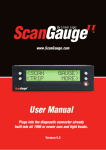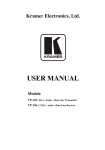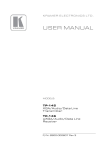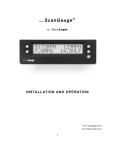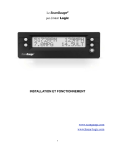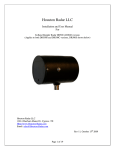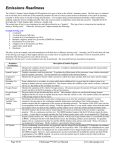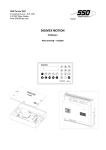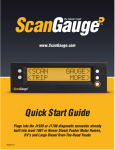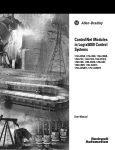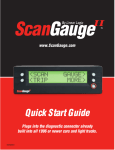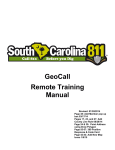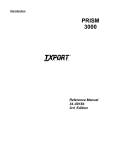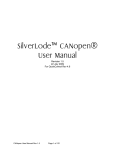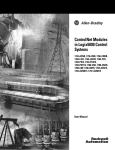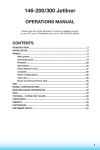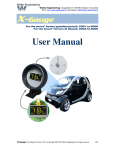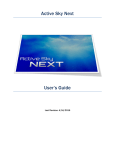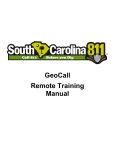Download User Manual
Transcript
www.ScanGauge.com
User Manual
Plugs into the J1939 or J1708 diagnostic connector already
built into most 1987 or Newer Diesel Pusher Motor Homes,
RV’s and Large Diesel Over-The-Road Trucks
Version 1.0
WARNING
Use of the ScanGauge while driving could lead to an accident and serious injuries.
The primary attention of the driver should always be on safe driving. As with any
gauge or other instrumentation system in a motor vehicle, the information should
be observed as part of a normal sequence of observations performed in the
operation of the vehicle. Changes to the selections in the ScanGauge should
only be made when it is safe to do so. The driver must remain attentive to driving
the vehicle.
The mounting of the ScanGauge and the routing of the cable connecting it to
the vehicle should be done with suitable caution so it does not create an unsafe
condition. This includes but is not limited to the following restrictions:
• Do Not mount the ScanGauge where it can obstruct the
view of the driver.
• Do Not mount the ScanGauge in a manner that could cause
it to be propelled through the vehicle during an accident
causing injury, such as over or near an air bag.
• Do Not route the cable in a manner that would interfere
with the operation of the vehicle controls.
RIGHTS AND OBLIGATIONS
The ScanGauge may be used on any number of vehicles. The software
contained in the ScanGauge is copyright protected by Linear Logic and may not
be transferred or disassembled and used in another product, in part or in whole.
The artwork used in generation of the circuitry is also copyright protected and
cannot be used in part or in whole by any person or entity without the express
written permission of Linear Logic.
© 2004-2012 by Linear Logic. All rights reserved.
2 — www.ScanGauge.com
Installing the ScanGauge
4
ScanGauge Overview
5
Basic Operation and Features
6
Installation
8
Initial Setup
11
Setting up your ScanGauge
12
Advanced Setup Options
14
Backlight Display
20
Refueling and Cost Adjustments
22
Operating Your ScanGauge
24
Digital Gauges
25
Trip Computers
28
Scan Tool
36
Advanced Features
40
X-GAUGE™
41
Performance Monitor™
48
Custom Commands
55
Troubleshooting
58
Where to Get Support
59
View Firmware Version of Your ScanGauge
61
Reset Your ScanGauge
62
Read or Set the Operating Mode
63
Warranty Information:
64
Version 1.0
Information in this manual and the specifications and operation of
the ScanGaugeD itself are subject to change without notice.
Table of Contents
3
Installing the ScanGauge
The ScanGauge is simple to install and requires no additional power
source other than that provided by the diagnostic connector.
There are, however, some important considerations when choosing
a location for your ScanGauge. Please see the Installation section
for detailed information.
ScanGauge Overview
5
Basic Operation and Features
6
Locating the J1939/J1708 Connector
8
Mounting Your ScanGauge
8
Connecting Your ScanGauge
8
Important Installation Considerations
10
4 — www.ScanGauge.com
ScanGauge Overview
Package Contents
• ScanGaugeD
• Velcro® Strips
• 6-ft J1939/J1708 Cable
• User Manual
• Quick Start Guide
Front
Side
A
C
B
D
Back
G
F
E
H
A.
Function/Selection Button
B.
Function/Selection Button
C.
Function/Selection Button
D.
Function/Selection Button
E.
HOME Button
Use the HOME Button to quickly get
back to the Home Screen
F.
LCD Display Screen
Displays the information the
ScanGauge records
G.
J1939/J1708 Connection Plug
Primary connector
H.
J1939/J1708 Connection Plug
Secondary connector or Daisy Chain
interface
The function buttons are used to make
selections and to navigate the menu
system of the ScanGauge.
Installing the ScanGauge
5
Basic Operation and Features
Menu and Selection Buttons
The ScanGauge interface is made up of 5 buttons; one HOME and 4 function/select buttons. The HOME
button, located in the lower right corner of the front face and marked with a red circle, has a single
function — to display the Home Screen. Pushing the HOME button will display the Home Screen as
shown on the next page. If the ScanGauge is off, pressing the HOME button will turn it on.
The function/select buttons are located at each corner of the display. The function of these buttons will
vary depending on the particular screen you are currently viewing.
Example Screens
<
$3.00
>
Fuel Cost
SAVE>
<DISPLAY
<SETUP
FILLUP>
MORE>
In general, when a “<” or “>” is displayed next to the
button, pressing the button will move you to the next or
previous selection for the currently selected feature .
To the left are a few examples of screens you may
encounter while using your ScanGauge. Use the diagram
for an explanation of possible button functions.
Automatic Mode Recognition
2 STORED CODES
<CODES
FRZD>
^1 RED
^1 BLUE
GRN ^1
SAVE>
Different vehicles use different types of signaling from
their computers. In most cases, the ScanGauge can
quickly determine which type your vehicle is using. You
don’t have to know which type it is for it to be used.
Automatic Repeat Buttons
Function/Action
Pressing the buttons and holding them for more than a
second will cause them to automatically repeat at a rate
of about 2 times a second. This allows for rapid stepping
to a value without a lot of button pressing.
>
Move to next selection or
do action
User Programmable Gauges
<
Move to previous selection
or do action
^
Increment up
+
Increment up or step
forward
-
Increment down or step
backward
Button Symbols
Symbol
6 — www.ScanGauge.com
Up to 25 trip, vehicle specific or special gauges can be
entered into the ScanGauge. These are stored in Flash
memory and will be retained even if there is a power loss,
but the user can change them as often as desired.
User Programmable Commands
Up to 10 commands can be generated, edited, saved and
sent to the vehicle computer. This allows for future codes
and some special commands to be added by the user.
<SCAN
<TRIP
GAUGE>
MORE>
SCAN
GAUGE
Use the Scan Tool to view and clear Trouble Codes and
turn off the check engine light
Use the function button next to GAUGE to
display up to 4 real-time Digital Gauges
TRIP
MORE
Press the function button next to TRIP to access the
built-in Trip computers. The Trip computers give you the
ability to view and track useful information about the trip
you take as you drive.
Press the function button next to MORE
to access the settings and configuration
options for the ScanGauge.
Flash Memory
The ScanGauge uses a type of memory that doesn’t require batteries or a source of power to maintain.
This means that your settings will not be lost if you disconnect the vehicle battery or disconnect the
ScanGauge.
Automatic Sleep Mode
About 12 seconds after turning off the vehicle or pressing a button after the vehicle engine is turned
off, the ScanGauge will automatically power down into a sleep mode. Starting the engine or pressing
the HOME button will automatically reactivate the ScanGauge, and it will return to the screen and lamp
settings it had just before it went to sleep.
If you need to disconnect the ScanGauge, wait until it has gone to sleep before
you do it. This will allow all settings and trip information to be saved in Flash
memory and restored when it is reconnected.
Customizable Backlight Color
Choose from 7 standard backlight colors or program your own for 63 possible colors. The backlight
intensity is also adjustable and can be set to Off, Low and High intensities.
Installing the ScanGauge
7
Installation
1. Locate the Diagnostic Connector
The connector is generally located under the
dash at the fire wall on the driver side and is
usually protected by a plastic cover. To remove
the protective cover, you must push the cover
while turning counter clockwise, then pull to
remove it.
2. Determine Plug Type
The universal plug included with
your ScanGauge is compatible
with both the J1939 (9pin) and
J1708 (6-pin) diagnostic port.
Match the end of the plug to the
connector, but do not plug it in at
THIS time.
Typical J1939/J1708 protective cover
6-pin connects to vehicles
that use the J1708 protocol
9-pin connects to vehicles
that use the J1939 protocol
3. Locate a Place For The
ScanGauge.
You can use the sticky-back Velcro® supplied with the ScanGauge to attach it to the location you
have chosen.
DO NOT mount the ScanGauge over an air bag cover where it could be
propelled by a deploying airbag.
4. Route The Cable.
Route the cable from the ScanGauge to your vehicle’s diagnostic connector. Be sure to keep the
cord from interfering with the pedals or operating controls of the vehicle.
8 — www.ScanGauge.com
5. Connect the small end of the cable
Plug the small end of the cable into the back or side of the
ScanGauge.
Small end of the cable
connects to your ScanGauge.
6. Turn the vehicle on.
Start your vehicle or turn the ignition to the ON position.
7. Plug the ScanGauge Plug Into The
Diagnostic Connector.
While inserting in the plug, you may have to rotate the plug to align the connector pins. Once the
pins are aligned, push firmly on the plug to complete the connection.
Once connected with the vehicle running or the ignition in the ON position, your ScanGauge will
display the Connecting Screen, and then quickly switch to the Home Screen.
When the Home Screen is displayed, your ScanGauge is connected and has established
communication with your vehicle’s computer.
Connecting...
<TRIP
MORE>
Connecting Screen
Up to 10
seconds
<SCAN
<TRIP
GAUGE>
MORE>
Home Screen
If it does not stop saying “Connecting...” or the screen goes blank after 60
seconds, refer to Troubleshooting on page 52.
The TRIP and MORE buttons can be used even if a connection is not established. If communication
with the vehicle ECU is not completed within about 75 seconds, the ScanGauge goes to sleep. It will
continue to attempt to connect when the vehicle is restarted or the HOME button pressed. When
communication has been established, the display will change over to that which was displayed the
last time it went to sleep or to the Home Screen.
8. If this is the first time it has been used on this vehicle, follow the
procedures outlined in Setting Up Your ScanGauge, on page 11.
Installing the ScanGauge
9
Important Installation Considerations
The ScanGauge has an operating temperature range of 0˚F to 160˚F (-18˚C to 71˚C). At higher temperatures, the display will become dark and difficult to read. At lower temperatures, the contrast will be
reduced and the characters will change more slowly. As long as the temperature doesn’t exceed –22˚F
to 176˚F (-30˚C to 80˚C), the display will return to normal operation when the ScanGauge temperature
returns to the normal operating temperature range.
•
•
•
•
A location in direct sunlight on the dashboard in a closed vehicle could exceed the normal operating temperature. The use of windshield shades or covering the ScanGauge with a piece of
paper can significantly reduce this temperature. If attached with Velcro®, you can also move it
temporarily to a location away from the sun.
DO NOT mount the ScanGauge over an air bag cover where it could be propelled by a deploying air bag.
A pin in the cable is connected to the vehicle’s 12V system. DO NOT short any pins of the small
connector to metal or other ground while the large end of the plug is plugged into the vehicle’s
diagnostic connector.
The location should be where it can easily be seen from the normal driving position. It should not
be placed where it will obstruct the driver’s view outside the vehicle or of other gauges.
10 — www.ScanGauge.com
Initial Setup
To get the most out of your ScanGauge, it is important to follow the setup
procedures to ensure your ScanGauge reports accurate information.
Setting Up Your ScanGauge
Initial Setup Overview
12
Advanced Setup Overview
14
Backlight Display Options
20
Refueling and Cost Adjustment
Initial Setup
22
The Fill Up Procedure
22
Fuel Cost Screen
22
Initial Setup
11
Setting Up Your ScanGauge
Initial Setup Overview
To properly use your ScanGauge, you must first set up the vehicle parameters. Basic setup parameters include, fuel tank size and units of measure. Advanced parameters are also available and are
covered later in this chapter.
Access the Setup Options
<SCAN
<TRIP
To access the setup screens, press the
function button next to MORE on the
Home Screen. Next press the function
button next to SETUP.
GAUGE>
MORE>
<DISPLAY
<SETUP
FILLUP>
MORE>
Displays the currently selected setup parameter
Use the upper buttons to move to the next or
previous setup parameter
Use the lower buttons to adjust the
currently selected setup parameter
Loop
<
DISTANCE
>
<
MILES
>
<
FUEL UNITS
>
<
TEMP UNITS
>
< PRESSURE UNITS >
<
GALLONS
>
<
°F
>
<
PSI
<
TANK SIZE
>
<
CURRENCY
>
<
100 Gallons
>
<
$
>
<
ADV SETTINGS
>
EDIT>
12 — www.ScanGauge.com
>
Loop
See page 14 for
Advanced Setup Options
Basic Setup Parameters
Setup Parameter
Distance Units
Fuel Units
Display
DISTANCE
FUEL UNITS
Options
Description
Miles
Kilometers
The Setup Parameters include multiple
units of measure settings, including
Distance, Fuel, Temperature and Pressure.
Gallons
Liters
Temperature Units TEMP UNITS Fahrenheit (˚F)
Celsius (˚C)
Each is set independently of the others and
can be used in any combination.
Making changes to these settings causes
your ScanGauge to use these units when
reporting and measuring data.
Pressure Units
PRESSURE
UNITS
PSI
KPA
MM
IN
Tank Size
TANK SIZE
0 - 9999
Gallons/liters
Is adjustable in 1-gallon or liter increments
depending on how you set the FUEL
UNITS parameter.
Currency Type
CURRENCY
$, £, ¥, 元 ,€
Choose the currency symbol ScanGauge
should use to display monitor values.
Tips for Setting the Tank Size
The size will use Gallons or Liters depending on the selection you made in the Fuel Units Screen (FUEL
UNITS). If the size in the manual is not in whole units, use the next lower value. For instance, if the
capacity is 80.5 gallons, use 80 gallons.
It is dangerous to run a vehicle out of fuel and can damage the fuel pump. Do
not rely on the fuel gauge or ScanGauge at low fuel levels or low remaining
distance or time.
Can ScanGauge Display Liters per Hundred Kilometers?
By default, ScanGauge will express fuel economy in Liters per Hundred Kilometers (LHK), provided you
have set fuel to LITERS and distance to KILOMETERS. For more information see LHK under Advanced
Setup on page 14.
Initial Setup
13
Advanced Setup Options
Overview
The Advanced Setup Options provide additional setup parameters you can use to adjust the functions
and features of the ScanGauge to suit both your vehicle and your preferences.
This section provides a brief overview of each of the advanced parameters but may not cover the full
scope of the subject the setting applies to.
For more information, visit: www.ScanGauge.com/support.
Accessing the
Advanced Setup Options
The Advanced Setup Options are
located within the SETUP menu. To
access the Advanced Setup Options
screens, press the lower right function
button next to MORE on the Home
Screen. Next press the lower left
function button next to SETUP.
Once on the Setup Screen, use the
upper left or right function buttons to
cycle through the available screens until
the screen displays ADV SETTINGS.
Press the lower right function button
next to EDIT to enter the Advanced
Setup Options.
<SCAN
<TRIP
GAUGE>
MORE>
<DISPLAY
<SETUP
FILLUP>
MORE>
<
DISTANCE
>
<
MILES
>
<
ADV SETTINGS
>
EDIT>
Click to access the
Advanced Setup Options
14 — www.ScanGauge.com
Advanced Setup Parameters
Setup Parameter
Display
Data Update Rate
UPDATE RATE
Speed Adjustment
SPEED
Alternate Speed
Reporting Method
SPEED PGN
Liters per Hundred
Kilometers
LHK
Options
Description
Slow
Normal
Fast
Max
Sets the rate in which ScanGauge
reports data. See below.
-99% - +99%
Sets the speed offset to compensate
for inaccurate speed readings. See
page 16.
NORMAL
ALT
Sets the speed reporting method
See page 17.
OFF
ON (Default)
Displays fuel economy in Liters per
Hundred Kilometers. See page 17.
Sleep Event
SLEEP EVENT
COMM
0 RPM
Sets the ScanGauge power down
event. See page 17.
ScanGauge wake
event
WAKE EVENT
Normal Volts
High Volts
Low Volts
Sets the ScanGauge power up
event. See page 18.
Horsepower
Adjustment
HPR
-99% - +99%
(Default 0)
Adjusts the Horsepower reading.
See page 18.
Fuel Usage
Adjustment
FUEL ADJ
-99% - +99%
(Default 0)
Adjusts the fuel usage
measurement. See page 18.
Trip Method
TRIPS
DAYs
AB
Sets the method the ScanGauge
uses to track and store trip data. See
page 18 and 19.
Visual DTC Alerts
DTC Alert
OFF
ON
Turns visual DTC alert on or off. See
page 19.
Clear DTC method
CLR DTC
NORMAL
ALT
Sets the method for clearing DTCs.
page 19.
Advanced Setup Options
15
Set the Update Rate
<
UPDATE RATE
>
You can adjust the rate in which ScanGauge reports
<
NORMAL
>
data. The update rate defaults to NORMAL which
updates the display about every 2 seconds. The
SLOW setting will reduce the update frequency to every 4 seconds, while the FAST setting will increase
the update frequency to 1 second.
You may also set the update rate to MAX which allows ScanGauge to update displayed data at the full
speed of the buss. If the vehicle reports data 10 times per second, then ScanGauge will update the
gauge screen 10 times per second. In some instances, this may cause the display to appear blurry as
the numbers change too quickly to read — particularly with speed and RPM gauges.
Set Speed Adjustments
The speed indicated by ScanGauge can be adjusted
< SPEED
0%
>
to compensate for changes in tire size, gear
changes, tire wear or any other factor that may affect
<
50> 50
>
the accuracy of your vehicle’s speedometer. It is
important to note that this adjustment only affects the ScanGauge’s indicated speed and distances, and
it does not affect the vehicle speedometer or odometer readings.
While viewing the SPEED Screen, the lower left and right function buttons can be used to increase or
decrease the selected adjustment in 1% steps.
The upper line displays the word SPEED and a percentage. The percentage is the adjustment factor.
The lower line displays 2 numbers: the left number is the speed reported by the vehicle and the number
on the right is the speed that will be shown by the ScanGauge after applying the correction factor.
An accurate way to set the speed is to use a GPS. With one person driving, the other person observes
the speed on the GPS and adjusts the percentage until the lower right number agrees with the speed
the GPS indicates.
For more information about the various methods of calculating your speed adjustment, visit us online at
www.ScanGauge.com/quick-tips/.
IMPORTANT: OBSERVE ALL SPEED LIMITS AND DRIVE SAFELY WHILE MAKING
THESE ADJUSTMENTS. THE DRIVER MUST NOT BE DISTRACTED BY TRYING TO
MAKE THESE ADJUSTMENTS WHILE DRIVING.
16 — www.ScanGauge.com
Speed PGN
Some vehicles use a different Parameter Group
Number (PGN) for transmitting speed. If the
ScanGauge does not report speed for either MPH
or KPH, change the SPEED PGN setting from
NORMAL to ALT.
<
SPEED PGN
>
<
NORMAL
>
LHK
Liters per Hundred Kilometers (LHK) is a popular way
to express fuel economy in Europe.
<
LHK
>
<
ON
>
By default, ScanGauge will express fuel economy
in LHK, provided you have set fuel to LITERS and
distance to KILOMETERS as outlined in the Basic Setup procedure (see page 12).
If you would prefer fuel economy to be express as Kilometers Per Liter (KPL), set the LHK parameter to
OFF. With LHK set to OFF, and fuel and distance set to LITERS and KILOMETERS, the ScanGauge will
now express fuel economy in Kilometers Per Liter (KPL).
IMPORTANT: Lower LHK values represent a higher fuel economy, unlike KPL
where a higher number represents higher fuel economy.
Set the Sleep Event
By default, the ScanGauge will shut down within 10-15
seconds of turning off the vehicle. If it does not shut
down, there is a small risk that one of the vehicle’s
ECUs and ScanGauge will stay on and drain the
battery.
<
SLEEP EVENT
>
<
COM
>
If the ScanGauge does not shut down, you can set the SLEEP EVENT parameter to 0 RPM. This will
have the effect of allowing ScanGauge to “sleep” when it sees 0 RPM for a period of 10-15 seconds.
Advanced Setup Options
17
Set Wake Event
The WAKE EVENT parameter allows you to set the
signal level ScanGauge looks for to power up.
<
WAKE EVENT
>
<
Normal Volts
>
The default setting is Normal Volts. This should work
for the majority of vehicles. If however, the ScanGauge has trouble either turning on, or staying powered
down, you may need to set the WAKE EVENT parameter to either High Volts, or Low Volts.
Trouble Powering Up
If the ScanGauge does not turn on when the vehicle is started, set the WAKE EVENT parameter to
Low Volts.
Trouble Staying Powered Down
If the ScanGauge turns off but then turns on for a short time and then repeats this pattern, set the WAKE
EVENT to High Volts.
Set a Horsepower Adjustment
ScanGauge reports Horsepower (HPR) as a builtin digital gauge. This parameter allows you to make
adjustments to the HP reading ScanGauge reports.
<
HPR
>
<
0%
>
If a dynamometer is used to determine the horsepower, this adjustment can be done to make the
ScanGauge agree with the dynamometer.
Adjust Fuel Usage
The FUEL ADJ function can be used to make the fuel
use readings on the ScanGauge more accurate.
<
Fuel Adj
>
<
0.0%
>
After each fill up of your vehicle’s tank, you should use
the built in FILLUP function (see page 22), to tell ScanGauge the tank has been filled. If you notice a
consistent discrepancy between the amount of fuel ScanGauge has reported as being used and the
actual amount of fuel you put in the tank, you can make a global adjustment using this parameter.
For instance, if you fill up, and the pump said it took 55 Gallons to fill the tank, but the ScanGauge said
you only used 50 Gallons, the error would be 10%. You would need to make the FUEL ADJ setting
10.0%. If ScanGauge reported more fuel had been used than the pump showed to refill the tank, the
adjustment would be a negative percentage.
Set the Trip Computer Method
ScanGauge provides a number of automatic trip
computers which can be handled in one of two ways.
18 — www.ScanGauge.com
<
TRIPS
>
<
DAYs
>
Trips can be automatically stored as TODAY and PREVIOUS DAY (the default method), or as TRIP A
and TRIP B.
The ScanGauge relies upon the power supplied by the diagnostic connector to write TODAY and
PREVIOUS DAY trip data to memory once the vehicle has been shut off. Some vehicles will cut power
to the diagnostic connector the moment the vehicle is shut off, causing ScanGauge to be unable to
write the trip data. If this is the case for your vehicle, you should set the TRIPS parameter to AB. This
will change the automatic trip storage method from TODAY and PREVIOUS DAY, to TRIP A and TRIP
B methods. To learn more about the differences between the two trip storage methods, refer to the Trip
Computer section beginning on page 28.
To test which method your vehicle should use, you can simply observe the ScanGauge when you shut
off the vehicle. If the ScanGauge backlight shuts off in less than 2 seconds of turning off the vehicle, then
you should set the TRIPS parameters to AB
While set to the AB method, ScanGauge will automatically track all trips through the TRIP A and TRIP
B trip computers.
Turn on Instant DTC alerts
When a DTC (diagnostic trouble code) is set, by
default, ScanGauge will store that code for later review
through the SCAN function (see page 36).
<
DTC Alerts
>
<
OFF
>
If you wish to be notified immediately when a DTC is detected, set the DTC Alerts parameter to ON.
It is important to note that DTCs may occur even when there are no problems. For instance, when the
key is turned on but the engine is not running, a “low oil pressure” DTC will be sent because there is no
oil pressure until the engine is running.
New DTC Detected
<SCAN
IGNORE>
This alert will be shown at each engine start. In this
case and you can choose to IGNORE it.
Set Alternate DTC Clear Methods
<
CLR DTC
>
Some vehicles use a different commands to clear the
DTCs. If you find that the DTCs are not being cleared
<
NORMAL
>
from the vehicle computer when using the CLEAR
function in the SCAN TOOL (see page 39), set the CLR DTC parameter to ALT and then try clearing
the set DTCs.
Be aware that some DTCs will not be cleared if the problem has not been corrected and the vehicle’s
computer continues to report the problem.
Advanced Setup Options
19
Backlight Display
Backlight Display Options
You can customize the backlight display of your ScanGauge. Options include the ability to set the intensity of the backlight, choose a standard built-in color for the backlight, and create your own custom color.
Access the Display Options
To access the Display Options Screen, press the function button next to MORE on the Home Screen.
Next, press the function button next to DISPLAY. Use the upper left and right function buttons to cycle
through the available options.
Home Screen
<SCAN
<TRIP
GAUGE>
MORE>
<DISPLAY
<SETUP
Loop
<
<
LAMP
HIGH
>
>
<
<
FILLUP>
MORE>
COLOR
LIGHT BLUE
>
>
< CUSTOM COLOR >
EDIT>
Change the Backlight Intensity
Use the lower left and right function buttons to adjust
the backlight intensity. Options include:
Backlight Color Options
Sequence
1
2
3
Setting
HIGH (Default)
LOW
OFF
20 — www.ScanGauge.com
<
<
LAMP
HIGH
>
>
Loop
Change the Backlight Color
Use the lower left and right function buttons to
cycle through the available colors.
<
<
COLOR
LIGHT BLUE
>
>
Use lower function buttons to choose a
backlight color
Backlight Color Options
Sequence
1
2
3
4
5
6
7
8
Color
Light Blue
User Defined (Custom Color)
Blue
Green
Blue-green
Red
Violet
Amber
Set a Custom Backlight Color
The backlight can be customized by setting the
intensity of the three basic colors — Red, Green
and Blue — for a total of more than 60 possible
colors. The example to the right is what you
would see for a Pink backlight.
To create your own color, start by pressing the
function button next to a color. This will cause it
to sequence through 4 possible values ranging
from off — a setting of 0, to full intensity — a
setting of 3. As you press the buttons, the
backlight will change to show the color result of
the current selections.
If you have previously set the intensity at LOW,
the display will show the color at the low intensity
level. If you had set it at HIGH, the display will
show the color at the high intensity level. Note:
there may be a small difference in color between
LOW and HIGH.
When you have the color you want, press the
function button next to SAVE. This will save the
color in Flash memory. You can change the color
as often as you want.
< CUSTOM COLOR >
EDIT>
^1 RED
^1 BLUE
GRN ^1
SAVE>
Custom Color Adjustments
Value
Color Intensity
0
0 intensity (Off)
1
1/4 intensity
2
1/2 intensity
3
Full intensity
Backlight Display
21
Refueling and Cost Adjustment
Improving the Accuracy of Your ScanGauge
The accuracy of your ScanGauge can be improved by following the Refueling and Cost Adjustment
procedures outlined in this section. These functions directly effect the fuel based trip computers – TANK
and TANK TO EMPTY. See page 32.
The Fill up Function
The FILLUP function allows you to adjust and enter the fuel level and cost values to help ScanGauge
maintain accurate TO EMPTY and FUEL COST computations. During initial setup, if you are not filling
the tank to capacity, you will need to estimate the amount of fuel in the tank.
Initial Setup
To set the tank level initially, access the FILLUP
screen and use the upper left and right function
buttons to adjust the “TANK=” value to what you
estimate is in the tank.
For instance, if your vehicle’s fuel gauge indicates
there is a half a tank of fuel, then adjust the
“TANK=” value to match 1/2 of the tank capacity.
<SCAN
<TRIP
GAUGE>
MORE>
<DISPLAY
<SETUP
FILLUP>
MORE>
Using the FILLUP Screen
Use the FILLUP screen each time you put fuel in
the tank. Adjust the number shown in the top line
using the upper left and right function buttons until
the number matches the amount of fuel you put
in the tank.
FILLUP Screen
You can increase the number in 10 gallon/liter
steps and decrease in 1 gallon/liter steps.
Fuel Cost Screen
If you’re tank is full, press the function button next
to “+10” until the “TANK=” value is the same as
the tank capacity.
Fuel Cost Screen
<-1
0
Tank=
85
<
$4.10
>
Fuel Cost
SAVE>
Push the SAVE button to complete the
FILLUP process and reset the TRIP
parameters related to fuel.
When you’re done adjusting the fuel, press the
NEXT button to access the Fuel Cost Screen. Use
the upper left and right function buttons to adjust the fuel cost, then press SAVE.
22 — www.ScanGauge.com
+10>
NEXT>
Helpful Hints
• If you fill up your fuel tank with your vehicle on an incline, it can have an effect on the amount of fuel
the pump can dispense into your tank.
• When filling your tank, let the pump shut off automatically. Do not top off.
• To maintain the most accurate “TO EMPTY” information, it is best to fill the tank to its capacity
• If you have no need to track the time and distance values of the “TO EMPTY’ and “TANK” but still want
to track fuel costs, you can simply skip the FILLUP Screen by pressing NEXT and then entering the
Fuel Cost. When you’re done, press the lower right function button next to SAVE.
Refueling and Cost Adjustment
23
Operating Your ScanGauge
The ScanGauge features a simple and easy-to-use, menu-driven design. After each
button is pressed, new selections will appear in the display prompting you for what
can be done next.
The HOME button (button with a yellow-orange circle around it) will take you back to
the starting point at any time, or activate the ScanGauge if asleep.
Digital Gauges
Overview
25
Digital Gauge Abbreviations
26
Trip Computers
Trip Computer Overview
28
Time-based Trip Computers
30
Resetting Current Trip Data
32
Fuel-based Trip Computers
32
Filling Up Your Tank
34
Scan Tool
Scan Tool Overview
36
What to Do if DTCs Are Found
37
Clearing Trouble Codes
39
24 — www.ScanGauge.com
Digital Gauges
Overview
The ScanGauge can display up to 4 digital gauges at a time. The gauges are updated in real time when
your vehicle is running and can be used to monitor the operating condition of your vehicle.
Access the Digital Gauges
From the Home Screen, pressing the button next to GAUGE causes the display to change to show the
currently selected gauges.
Home Screen
<SCAN
<TRIP
GAUGE>
MORE>
1937RPM
16.2MPG
55MPH
3.40GPH
Push the function buttons to cycle through the
available digital gauges.
Selecting the Gauges
Pressing the button next to one of the gauges will allow you to change the gauge that is displayed in that
position. Pressing a button repeatedly, allows you to cycle through all the available gauges.
The selection will continue through all of the gauges and then loop back to the starting gauge. This gives
you the ability to customize the gauge display to show the gauges you’re most interested in.
The information available will vary from vehicle to vehicle. If the information is not available for a certain gauge, no data will be shown for it. If the same gauge is selected for
more than one position, only one of them will show data (if it is available). The other positions will show the abbreviation, but no data.
Operating Your ScanGaugeD
25
Gauge Abbreviations
The following table shows what the gauge names. In some cases, the unit selections made in the Basic
Setup Parameters (see page 12) will determine the gauge abbreviations.
The information available will vary from vehicle to vehicle. If the information is not available for a certain
gauge, no data will be shown for it. If the same gauge is selected for more than one position, only one of
them will show data (if it is available). The other positions will show the abbreviation, but no data.
Gauge
Name
Description
BST
Boost Pressure
This indicates the pressure in the intake manifold. It is reported in
PSI by default but can be changed to KPA, MM, or IN if desired.
MPG
KPG
MPL
LHK
KPL
Miles Per Gallon
Kilometers Per Gallon
Miles Per Liter
Liters Per 100Km
Kilometers Per Liter
Instant fuel economy is updated about every 2 seconds at the
NORMAL update rate . Small changes in throttle position or load
while driving will show almost immediate changes in this gauge.
MPH
KPH
Miles Per Hour
Kilometers Per Hour
Speed in the units selected
RPM
Revolutions Per Minute
The RPM of the engine
TPS
Throttle Position Sensor
In some vehicles, a closed throttle will read 0 and full throttle will
read 100. Other vehicles will have a higher value than 0 for a closed
throttle and a full throttle value less than 100.
FWT
CWT
F˚ - Water Temperature
C˚ - Water Temperature
Water/Coolant temperature
A vehicle with a 50/50 mix of coolant and water will not boil over until
about 265˚ F at sea level. This will be reduced at higher elevations.
AVG
Average Fuel Economy
This is the current average fuel economy and is updated about every
2 seconds (normal rate).
TFC
Trip Fuel Cost
This is the total fuel cost for the current trip.
CPM
Cost Per Mile
Cost of fuel per mile at this time
26 — www.ScanGauge.com
Add Custom Gauges
The ScanGauge features the exclusive X-GAUGE™ programmable gauge system
allowing you to add custom, vehicle specific gauges to the digital gauge set.
For an overview of the X-GAUGE™ system, see page 41. For an up-to-date list of known X-GAUGE™ codes, visit us
online at: www.ScanGauge.com/support
Gauge
Name
Description
VLT
Battery Voltage
Normal running battery voltage is between 13 and 15. When the
engine is off it should be between 11 and 13. Voltages higher than
15 volts can damage batteries and electrical components. Voltages
below 13 when the vehicle is running could indicate poor charging of
the battery. Voltage below 11 when the engine is off could indicate a
low battery charge or a shorted battery cell.
FIA
CIA
F˚ - Intake Air Temperature
C˚ - Intake Air Temperature
Temperature of the air going into the engine. At highway speeds,
this will typically be a few degrees higher than the outside air
temperature. At idle or low speed, it may be much higher in
temperature than the outside temperature due to the low airflow into
the engine and the high under-hood temperatures warming it up.
TFT
Transmission Fluid
Temperature
This indicates the transmission fluid temperature in either F˚ or C˚as
selected in the setup procedure
GPH
LPH
Gallons Per Hour
Liters Per Hour
Fuel consumption rate in the selected units. This is sensitive to
throttle, gear and loading changes.
OIL
Oil Pressure
This indicates the engine oil pressure in the units (PSI/IN/KPA/MM)
as selected in the setup procedure
LOD
Engine Loading
This is a percentage of the maximum power available currently
being generated. In some vehicles it is the maximum available at the
present RPM.
HPR
Horsepower
Displays the calculated Horsepower your vehicle is currently making.
This value can be adjusted for accuracy through the Advanced Setup
parameters (see page 14).
Operating Your ScanGaugeD
27
Trip Computers
Overview
The ScanGauge features 5 built-in trip computers. The trip computers automatically store a set of useful
information about the trips you have taken in your vehicle and are updated in real time as you drive.
Built-in Trip Computers
Trip Computer
Display Name
Available Information
Current Trip
CURRENT
Trip MPG
Trip Fuel Used
Today’s Trips/
First Trip
TODAY
Previous Trips
PREVIOUS DAY
First Trip †
TRIP A
Second Trip †
TRIP B
Maximum Coolant Temperature
Distance
Maximum RPM
Trip Elapsed Time
Maximum Speed
Average Speed
Trip Fuel Cost
Trip MPG
Trip Fuel Used
TANK
Tank Trips*
Distance
Trip Elapsed Time
Average Speed
Trip Fuel Cost
Fuel Remaining for the Current Tank
TANK TO EMPTY
Distance Remaining Before Tank Is Empty
Time Remaining Before Tank Is Empty
† The TRIP A and TRIP B trip computers are an optional method for tracking trip data. You can activate
these trip computers through the ADV SETTINGS menu. See page 14.
* For ScanGauge to maintain accurate tank information, you must follow the Fill-up Procedure outlined
in the Filling Up Your Tank section on page 34.
28 — www.ScanGauge.com
Accessing the Trip Computers
From the Home Screen, press the
lower left function button next to
TRIP, then push the function button next to TRIPS to access the trip
computers. Pushing the lower left
function button allows you to cycle
through the available trip computers.
<SCAN
<TRIP
GAUGE>
MORE>
TRIP FUNCTIONS
<TRIPS
<
12.3 MPG
<CURRENT
PERF>
>
<
RESET>
14.3 MPG
Current Trip
<
15.1 MPG
>
<PREVIOUS DAY
Previous Day’s Trip
<
>
175.1 MILES
<TANK
<TODAY
>
*
Tank Trip
Today’s Trip
Viewing Available Trip Data
Pressing the upper right or left button will allow you to cycle through available information for the selected
trip computer. Selecting the lower right button next to RESET, allows you to reset current trip data.
Displays the data stored for the currently
selected Trip Computer
Push the upper left and right function buttons
to cycle through the available Trip data
Push the lower left function button to cycle
through the available Trip computers
<
0.5 HOURS
<CURRENT
>
RESET>
Typical Trip Computer Display
Displays the currently selected Trip computer
Operating Your ScanGaugeD
29
Time-based Trip Computers
The Current Trip (CURRENT), Today’s Trip (TODAY) and Previous Day’s Trip (PREVIOUS DAY)
computers all track similar information for different time periods.
The ScanGauge automatically records trip data as you operate your vehicle. The information from
the Current Trip is automatically reset each time you shut off your vehicle for more than 3 minutes.
Information from the Today’s Trip is automatically transferred to the Previous Day’s Trip when the engine
has been shut off for 8 to 10 hours.
To view the trip data, push the upper left or right function buttons to cycle through the available data.
The diagram below uses the Current Trip screens as an example.
<
12.3 MPG
<CURRENT
<
125
WT MAX
<CURRENT
<
<
<
30 — www.ScanGauge.com
>
RESET>
$ 9.90 COST
<CURRENT
>
RESET>
65 MPH MAX
<CURRENT
>
RESET>
2879 RPM MAX
<CURRENT
>
RESET>
>
RESET>
<
3.30 GALLONS
<CURRENT
<
40.6 MILES
<CURRENT
<
<
>
RESET>
35 MPH AVG
<CURRENT
>
RESET>
0.5 HOURS
<CURRENT
>
RESET>
>
RESET>
Alternate Trip Computers
There may be instances where you want more control over how the trip computers store data.
ScanGauge provides an alternate method which replaces the standard TODAY and PREVIOUS DAY
trips with a TRIP A and TRIP B.
To set ScanGauge to use the alternate trip method, use the TRIPS parameter located in the ADV
SETTINGS menu (See page 14) and set it to AB. While set in the alternate trip methods, the TODAY
and PREVIOUS DAY trip computers will be replaced with TRIP A and TRIP B. These new trip computers
will automatically begin recording trip data as you operate your vehicle.
Each trip computer (Trip A & Trip B) will track all trips, but will allow you to RESET them independent
of each other at any time. To view the trip data, push the upper left or right function buttons to cycle
through the available data.
The diagram below uses the Trip A screens as an example.
<
15.1 MPG
<TRIP A
<
125
<TRIP A
<
<
>
RESET>
>
RESET>
$ 9.90 COST
<TRIP A
>
RESET>
65 MPH MAX
<TRIP A
<
WT MAX
2879 RPM MAX
<TRIP A
>
RESET>
<
3.30 GALLONS
<TRIP A
<
40.6 MILES
<TRIP A
<
<
>
RESET>
35 MPH AVG
<TRIP A
>
RESET>
0.5 HOURS
<TRIP A
>
RESET>
>
RESET>
>
RESET>
Operating Your ScanGaugeD
31
Resetting Current Trip Data
The Current Trip data is automatically reset after
about 3 minutes of the ScanGauge being asleep.
<
12.3 MPG
<CURRENT
You can reset the trip data at any time for the
Current Trip computers. To reset trip data, simply
press the function button next to RESET as shown
in the example above.
>
RESET>
Push the lower right button to reset all
trip data for the CURRENT trip
Today’s Trip Data
Notice that there is no RESET for TODAY. The
Today Trip will automatically reset after the engine
has been off for 8 to 10 hours (as when sitting
overnight). The values for TODAY will be transferred
to the Previous Day’s Trip and the values that were
in Previous Day’s Trip are discarded.
<
65 MPH MAX
<TODAY
>
*
The asterisk (*) indicates the ScanGauge
may have incomplete trip data
The asterisk (*) in the lower right corner indicates that the ScanGauge was disconnected for at least
part of the day and the data may not be complete. This will be transferred to the Previous Day’s Trip
along with the data.
If the vehicle is driven early in the morning and then not again until late that evening, the
data will be transferred to the previous day. If the vehicle is driven until late at night and
then used again very early in the morning, the data will stay in the Today’s Trip. The end
of the Today’s Trip requires the vehicle be off, the ScanGauge connected, and the vehicle
not driven for 8 to 10 hours.
Fuel-based Trip Computers
The Tank Trip (TANK) and To Empty (TANK TO EMPTY) trip computers can tell you much about the
current tank of fuel. For instance, you can learn how much fuel you have used and how far you have
traveled since your last fill-up, or how much fuel you have left and the approximate distance you can
travel before needing to fill up.
For ScanGauge to maintain accurate Tank Trip information, you must follow the Refueling
and Cost Adjustment procedures during initial setup outlined on page 22 and follow the
Fill-up Procedure outlined in the Filling Up Your Tank section on page 34, for each
subsequent refueling.
32 — www.ScanGauge.com
Tank and Tank to Empty Trip Computers
The Tank Trip shows different types of information in some cases from the other trips. The Tank Trip
substitutes TANK TO EMPTY data in place of MAXIMUM data.
For instance, the Tank Trip can show you MPG as well as the distance and the amount of time you
have traveled on the current tank of fuel. In contrast, the TANK TO EMPTY trip data will show you the
amount of remaining fuel in your tank and the approximate distance and time you can travel before
needing to refuel.
The Tank Trip information is reset each time you fill up your tank, and follow the Fill-up Procedure
shown on page 34.
Loop
<
13.9 MPG
>
< 12.60 GALLONS >
<TANK
*
<TANK
*
<
>
<
>
<TANK TO EMPTY
*
<TANK
*
<
>
7.40 GALLONS
175.1 MILES
102.8 MILES
>
<
<TANK TO EMTPY
*
<TANK
*
<
>
1.8 HOURS
3.1 HOURS
>
<
<TANK TO EMPTY
*
<TANK
<
>
$ 3.80 COST
<TANK
*
56 MPH AVG
*
Loop
The displays above tell you that if your mileage remains the same as it has since the last fill-up, you
have approximately 7.4 gallons of fuel remaining, and that you will run out of fuel in 102.8 miles in
about 1.8 hours.
The estimate of distance and time to empty is based on the economy that has been obtained so far on
the current tank of fuel. Right after refueling, these values will change fairly quickly. As more of the fuel
has been burned from the tank, the readings will stabilize.
Operating Your ScanGaugeD
33
It is possible to see the distance and time to empty increase as you drive. The distance can increase as
you drive at a steady fuel-efficient speed. This causes the fuel economy for the tank to rise; and applying
this higher fuel efficiency to the fuel remaining in the tank can actually result in more remaining distance.
If you drive slower than the average speed of the tank so far, the time to empty can increase.
To maintain accurate To Empty information, you must use the following FILLUP procedure shown under
Filling Up Your Tank to indicate the vehicle tank has been refilled. It is also necessary to fill the tank to
make the TO EMPTY information correct.
Filling Up Your Tank
To maintain accurate information in the Tank Trip
and To Empty computers, you must tell your
ScanGauge that you have added fuel to your
vehicle’s tank. To maintain the most accurate
To Empty information, you should fill that take
to capacity each time you put fuel in the vehicle.
If this is not possible, then you should enter the
amount of fuel you put in the tank.
The Fill Up Function
The FILLUP function allows you to adjust and
enter the fuel level and cost values to help
ScanGauge maintain accurate TO EMPTY and
FUEL COST computations. To access the FILLUP
screen from the Home Screen, press the lower
right function button next to MORE. Next, press
the upper right function button next to FILLUP.
Filling the Tank to Capacity
To tell ScanGauge you have filled the tank, use the
upper left and right function button to adjust the
“TANK=” value until it matches the tank capacity.
When you’re done, press the NEXT function
button to continue to the Fuel Cost Screen.
<SCAN
<TRIP
GAUGE>
MORE>
<DISPLAY
<SETUP
FILLUP>
MORE>
FILLUP Screen
<-1
0
Tank=
85
+10>
NEXT>
Fuel Cost Screen
<
$4.10
>
Fuel Cost
SAVE>
Push the SAVE button to complete the
FILLUP process and reset the TRIP
parameters related to fuel.
Partially Filling the tank
To tell ScanGauge you have added fuel to the tank, use the upper left and right function button to adjust
the value in the top line until it matches the amount of fuel you actually put in the tank. As you adjust the
bottom value next to “Tank=” will reflect the amount of fuel ScanGauge believes in the tank.
When you’re done, press the NEXT function button to continue to the Fuel Cost Screen
34 — www.ScanGauge.com
Push to increase the amount of fuel added to the tank
by 10 gallons/liters increments
Displays the amount of fuel
added to the tank
FILLUP Screen
Push to decrease the amount
of fuel added to the tank in one
gallon/liter increments
<-1
0
Tank=
85
+10>
NEXT>
Displays the amount of fuel
ScanGauge believes is in the tank.
Fuel Cost Screen
The Fuel Cost screen allows ScanGauge to track accurate trip fuel costs. Use the upper left and right
function buttons to adjust the fuel cost. When you’re done, press SAVE
There will be variations in the agreement of the pump fuel used and the ScanGauge indicated fuel use
from tank to tank due to:
•
•
•
•
•
Different shutoff levels of the fuel pumps
Different tilt of the vehicle at the fuel pump due to ground slope or vehicle loading
Different temperature of the fuel (changes density – best to refill in the morning when the fuel is
colder)
Variations in vehicle sensors due to temperature and time
Pump accuracy limits
These are just some of the variables that limit absolute accuracy and show why you should never trust
a low reading of DISTANCE in the Tank to Empty Trip to believe you will be able to make it to the next
gas station.
Important Considerations
You should refill the vehicle when there is above 50 miles/km remaining. Pushing below 50 could
result in running out of fuel.
When filling your tank, let the pump shut off automatically. Do not top off.
To maintain the most accurate TO EMPTY information in the ScanGauge’s trip computers, you
should fill your tank to capacity.
Operating Your ScanGaugeD
35
Scan Tool
Scan Tool Overview
The ScanGauge features a built-in Scan Tool that you can use to view and clear Diagnostic Trouble
Codes (DTCs), view the parameters that were present when a Trouble Code was logged, and turn off
the Check Engine light.
Access the Scan Tool
From the Home Screen, press the function button next to SCAN to access the built-in Scan Tool. When
you press SCAN, the ScanGauge immediately checks your vehicle’s computer for any DTCs. Generally,
a Trouble Code will cause your Check Engine light turn on.
<SCAN
<TRIP
0 STORED CODES
<CODES
CLEAR>
No Codes Found
If no codes where found and your Check
Engine light is still on, you can use the CLEAR
function.
36 — www.ScanGauge.com
GAUGE>
MORE>
2 STORED CODES
<CODES
CLEAR>
Trouble Codes Found
If ScanGauge detects Trouble Codes, the top
line will indicate the number of codes found.
See page 37 for more information about what
to do when Trouble Codes are found.
If No Codes Are Found
If no codes where found and your Check Engine
light is still on, you may need to use the CLEAR
function.
0 STORED CODES
<CODES
CLEAR>
If this does not turn off the check engine light,
you may need to adjust the setting of CLR DTC
parameter to ALT in the Advanced Setup (see
page 19). Then, use the CLEAR function again.
No Codes Found
What to Do if DTCs Are Found
If your vehicle’s Check Engine light is on, that’s a good
indication that your vehicle may be storing Trouble
Codes (DTCs). If ScanGauge indicated it has detected
DTCs, you can access the specific Error Code ID (ID)
and related Failure Mode ID (FM) by pressing the
function button next to CODES. If more then one code
is stored, you can use the lower left and right function
buttons to step through the stored codes.
2 STORED CODES
<CODES
CLEAR>
Displays the Failure Mode ID. See page 38 for
list of standard modes
Displays the Error Code ID Number
Push to step back through detected
trouble codes
#
<1
ID FM
100 1
CNT
42>
Displays the number of the currently selected
trouble code
Displays the number of times the DTC has
been detected (Max 127)
Push to step forward through detected
trouble codes
Operating Your ScanGaugeD
37
Decoding DTCs
DTCs or Detected Trouble Codes, vary from
vehicle to vehicle. The DTC for vehicles that
use J1939 and J1708 protocols are made up of
two parts; an Error Code ID and a Failure Mode
ID. The two parts combine to form the DTC.
Error Code ID (ID)
The Error Code number indicates the system
or component that has reported the problem.
There are hundreds of possible error codes,
so finding information about your specific
code can be a challenge. An excellent way to
determine the system or component the Error
Code refers to is to use a good search engine
on the Internet.
Use the Error Codes along with the model and
year of your vehicle as the search words. You
can add your engine type to narrow the search.
Failure Mode ID (FM)
The Failure Mode ID (FM) indicates the nature
of problem that was detected. The table to the
right lists the standard Failure Mode IDs.
Example DTC Code
The code shown in the example screen to the
upper right - “100 1” would indicate:
Low Oil Pressure
ID 100 = Oil Pressure
FM 1 = Data valid but below normal
operating range
38 — www.ScanGauge.com
#
<1
ID FM
100 1
CNT
42>
The above example indicates low oil pressure.
Failure Mode IDs
ID
Description
0
Data valid but above normal
operational range
1
Data valid but below normal
operational range
2
Data erratic, intermittent or incorrect
3
Voltage above normal or shorted high
4
Voltage below normal or shorted low
5
Current below normal or open circuit
6
Current above normal or grounded
circuit
7
Mechanical system not responding
properly
8
Abnormal frequency, pulse width,
or period
9
Abnormal update rate
10
Abnormal rate of change
11
Failure mode not identifiable
12
Bad intelligent device or component
13
Out of calibration
14
Special Instructions
15
Reserved for future assignment
Clearing Trouble Codes
After Scanning for codes, pressing the lower
right function button next to CLEAR will result
in a prompt from ScanGauge to verify that you
want to clear the Trouble Code(s) and turn off the
Check Engine light.
If you want to continue and clear the Trouble
Codes, press YES. If you decide you do not want
to clear the Trouble Codes, press NO.
2 STORED CODES
<CODES
CLEAR>
Clear Codes???
<YES
NO>
When the YES button is pressed, ScanGauge
will send out a signal to clear all of the Trouble
Codes.
While ScanGauge is waiting for a response from
the vehicle, the screen may display the message
WAITING.
If the process is successful, the display will show
CODES CLEARED. This should also turn off the
Check Engine light on the dashboard and clear
any stored data related to the DTCs
WAITING
Codes Cleared
If the display shows NO RESPONSE, the clear
codes command was unsuccessful and your
vehicle is not responding to the clear command.
This may indicate that your vehicle uses a different command to clear the DTC. To set ScanGauge to
use an alternate method for clearing codes, refer to Set Alternate DTC Clear Method section in the
Advanced Setup Options on page 19.
Operating Your ScanGaugeD
39
X-GAUGE™
Advanced Features
The ScanGaugeII includes a number of advanced features and
functions, such as the exclusive X-GAUGE™ programmable
gauge system, the built-in vehicle Performance Monitor™ and
the ability to send your vehicle’s ECU Custom Commands.
TM
TM
TM
Program Custom Gauges with X-GAUGE™
X-GAUGE Overview
41
Add or Edit an X-GAUGE
42
Display a Trip Value as an X-GAUGE
46
Using an X-GAUGE
47
Performance Monitor
Performance Monitor Overview
48
Recording a Performance Run
49
Accessing Performance Monitor Data
50
Reading Performance Monitor Data
51
Set a Gauge for Performance Monitoring
53
Save a Performance Run
54
Helpful Tips
54
Custom Commands
Custom Commands Overview
55
Enter and Save a Command
56
Send a Command and Get a Response
57
40 — www.ScanGauge.com
TM
Overview
Your ScanGauge features the exclusive X-GAUGE™ Programmable Gauge System that provides you a
method to tap into this additional information. The X-GAUGE feature allows you to extend the capabilities
of your ScanGauge to include things like: vehicle specific gauges, trip data as gauges, and special function
gauges.
Programing a new X-GAUGE and saving it to your ScanGauge is simple and easy. Each X-GAUGE consists
of specific alpha-numeric strings, or “codes,” you enter into the ScanGauge via the front panel push buttons.
Your ScanGauge provides enough internal memory to save up to 25 X-GAUGES.
An extensive library of X-GAUGE codes for many different vehicles can be found on our
Web site at www.scangauge.com/support
<SCAN
<TRIP
GAUGE>
MORE>
Accessing X-GAUGE Features
From the Home Screen, press the lower
right function button twice, next to MORE.
Next, use the upper left and right function
buttons to cycle through the available
options until the screen titled X-GAUGE
appears.
<DISPLAY
<SETUP
<
VPW
FILLUP>
MORE>
MODE
>
CHANGE>
Finally, press the lower right function
button next to EDIT to enter X-GAUGE.
<
XGAUGE
<XGAUGE
<EDIT
>
EDIT>
0>
EXIT>
Advanced Features
41
The X-GAUGE Home Screen
From the X-GAUGE Screen, pressing the upper left and upper right buttons allows you to cycle through
the 25 available memory slots (0-24). Each memory slot can store an individual X-GAUGE.
If the memory slot is in use, the 3-letter name for the gauge will be shown in the top line next to the
memory number. If no name is shown, this memory slot is not being used.
Currently selected X-GAUGE memory slot
If a slot is in use, the currently selected
X-GAUGE name will be displayed here
Push the upper left or right function buttons to
cycle through the available memory slots
<XGAUGE
<EDIT
Push the lower left function button to edit
the currently selected memory slot
AVG 21>
EXIT>
X-GAUGE Home Screen
Add or Edit an X-GAUGE
To add a custom X-GAUGE to your ScanGauge, you will need to program the gauge parameters into
the ScanGauge using the X-GAUGE Program Parameters Screens. In order to read the data from the
vehicle and set up a functional X-GAUGE, you need to have the following information:
Command to send
How to identify a response to the command
Where to find the data in the response
How to scale, offset and display the data.
•
•
•
•
The X-GAUGE Program Parameter Screen
An X-GAUGE is entered into the ScanGauge through a series of X-GAUGE Program Parameters. Each
X-GAUGE consists of 4 program parameter screens — TXD, RXF, RXD and MTH — as well as one
gauge name screen.
Press the upper right function button to move the
cursor forward and move the next character
Current cursor position
Push the upper left function button to increment
the character at the current cursor position up
Push the lower left function button to increment the
character at the current cursor position down
+686AF10100_
TXD
»
OK>
Displays the current X-GAUGE Program Parameter
Press the lower right function button to move to the next
X-GAUGE Program Parameter
42 — www.ScanGauge.com
Step 1
Programming Your Own X-GAUGE
Step 1 - Select an Empty Memory Slot
Start by selecting an empty memory slot by using
the upper left and right buttons. Next, press the EDIT
button.
Step 2 - Enter the TXD Data
The TXD on the lower line means that the value
being entered is the command that will be transmitted
to the vehicle’s computer.
IMPORTANT: Entries must be an
even number of characters. If an odd
number of characters is entered, a 0
will be appended to the string to make it even.
A nonspace entry must be made in the first
character location, or the X-GAUGE will not be
an active gauge.
If the TXD value is blank, no name will be shown;
and this X-GAUGE memory will not appear as a
selectable gauge.
Step 3 - Enter the RXF Data
The RXF Screen is the entry for the receive filter.
This value tells the ScanGauge what to look for in a
response from the vehicle’s computer.
Also, some of the entries tell the ScanGauge how
to display the data. Choices are integer, tenths,
hundreds, hexadecimal or on/off. There are also
some fields that can turn any trip value into a gauge.
When you’re done, press the OK button to proceed
to the next step.
Step 4 - Enter the RXD Data
The RXD Screen is the entry that tells the ScanGauge
where the data and its size are in the response.
Entry in this screen is done the same as the other
X-GAUGE entry screens. When you’re done, press
the OK button to proceed to the next step.
<XGAUGE
<EDIT
0>
EXIT>
Step 2
+_
-
»
OK>
TXD
»
Step 2 Continued
+686AF10100_
TXD
»
OK>
Step 3
+000000000000
»
_
RXF
OK>
Step 4
+0000
_
-
RXD
»
OK>
Step 5
+000000000000
»
_
MTH
OK>
Step 6
+AAA
_
-
»
NAME OK>
Step 7
<XGAUGE
<CANCEL
AAA 0>
SAVE>
Advanced Features
43
Step 5 - Enter the MTH Data
The MTH (math) screen tells the ScanGauge the math needed to scale and/or offset the value received
for the X-GAUGE entry screens. When you’re done, press the OK button to proceed to the next step.
Step 6 - Give Your Gauge a Name
The Name Screen allows you to input a 3-letter designator for the name of the gauge you are making.
This screen allows a complete ASCI set of characters to be used. This includes punctuation and
symbols. You can give the gauge any 3-character name. Please note, you can give your new gauge a
name that matches those that are already defined. This should be avoided as it can cause confusion.
When you’re done, press the OK button to proceed to the next step.
Available ASCI Characters
A
B
C
D
E
F
G
H
I
J
K
L
M
N
O
P
Q
R
S
T
U
V
W
X
Y
Z
a
b
c
d
e
f
g
h
i
j
k
l
m
n
o
p
q
r
s
t
u
v
w
x
y
z
1
2
3
4
5
6
7
8
9
0
!
@
#
$
%
^
&
*
(
)
-
+
{
|
}
!
~
;
:
‘
,
<
.
>
/
?
[
]
_
«
°
Step 7 - Saving Your X-GAUGE
To save your new X-GAUGE programming, press the lower right function button next to SAVE. If you
wish to discard the changes you have made, press CANCEL. This will cause all the modifications to the
X-GAUGE memory slot to be canceled and not saved.
<XGAUGE
<EDIT
44 — www.ScanGauge.com
AAA 0>
EXIT>
Pressing SAVE will return you to the X-GAUGE
Home Screen. The new X-GAUGE name will also
appear in the top line, next to the memory slot
number.
Copying an X-GAUGE
To a Different Memory Slot
If you want to program a new X-GAUGE
that is very similar to one you have already
entered, you can copy the program
parameter data in one X-GAUGE memory
slot to another.
Step 1 (select an X-GAUGE)
<XGAUGE
<EDIT
<XGAUGE
Follow Steps 2 thru 6 of 1>
Programing Your Own X-GAUGE
<EDIT
EXIT>
Step 1 - Select an X-GAUGE to Copy
Start by selecting the X-GAUGE you
would like to copy. Use the upper left and
right function buttons to cycle through the
X-GAUGE memory slots until you locate the
X-GAUGE you want to copy. Next press the
lower left function button next to EDIT.
Step 7
Steps 2-6 - Edit The Program Parameters
Step through the settings and edit the
selected X-GAUGE’s program parameters
as needed for the new X-GAUGE.
Step 7 (continued )
Step 7 - Change Memory Slot and Save
Before pressing SAVE, use the upper left
and right function buttons to select a new
memory slot.
AAA 0>
EXIT>
<XGAUGE
<CANCEL
<XGAUGE
<CANCEL
* ABC 0>
SAVE>
ABC 1>
SAVE>
Saving an X-GAUGE in a particular memory
slot will overwrite any X-GAUGE data that may
already be saved in that memory slot.
If an asterisk (*) is present in the top line
next to the new X-GAUGE name, then there is already an X-GAUGE saved in that memory slot. Saving
the new X-GAUGE in that particular slot will overwrite any X-GAUGE data already present in that
memory slot. Once you have the desired memory slot selected, press lower right function button next
to SAVE. All the data will be written to that X-GAUGE memory slot, leaving the previously selected
memory slot unchanged.
Disabling an X-GAUGE
To disable an X-GAUGE already in memory, start as if you were going to edit the gauge. In the TXD
Screen, change the first character to a space. Continue to step through the editing fields by pressing the
lower right function button next to OK and press SAVE to exit the screen. This will actually delete the
data to transmit, which tells the ScanGauge not to use this X-GAUGE. The name will not be displayed.
If you put transmit data back into this gauge, it will be reactivated.
Advanced Features
45
Displaying a Trip Value as an X-GAUGE
You can set any of the built-in trip values and
have them displayed as a gauge. This allows you
to monitor trip functions along with other gauge
functions.
In the example to the right, a custom X-GAUGE that
displays the Time Driven Today is set up.
Step 1
<XGAUGE
<EDIT
Step 2
Step 1
To get started, choose an empty memory slot from
the X-GAUGE Screen. Then press the lower left
function buttons next to EDIT.
+51_
-
Step 2
In the TXD Screen, the first character determines
which trip function will be displayed. Choose a
number from the Available Trip Parameters chart
on the next page.
Step 3
The second character determines which trip to use.
Choose a number from the Trip Designations chart
on the next page.
Step 4 - 5
When you’re done, press the lower right function
button next to OK to move to the next screen.
2>
EXIT>
TXD
»
OK>
+800000000000
»
_
RXF
OK>
Make
+0000
_ no changes to the RXD and»
parametersOK>
- MTH program
RXD
Step 6
Step 3
For RXF, make the first character an 8 as shown to
the right.
+TDT
-
An 8 as the first character is a special condition that
tells the ScanGauge that this is to be a trip gauge. All
values after the 8 are ignored.
When you’re done, press the lower right function
button next to OK to move to the next screen.
Step 7
<XGAUGE
<CANCEL
»
NAME OK>
TDT 2>
SAVE>
Steps 4 and 5
Do not make any changes to the RXD and MTH screens. Simply press the lower right function button
next to OK until you reach the name screen.
46 — www.ScanGauge.com
Available Trip Parameters
Parameter
Trip Name
Step 6
Enter a name for your new X-GAUGE. For this
example, we used TDT for Time Driven Today.
When you’re done, press the lower right function
button next to OK, to move to the next screen.
0
Average Fuel Economy
1
Fuel used
2
Max Coolant Temperature or
Fuel Remaining for TANK trip
3
Distance
4
Max RPM or Distance to
Empty for TANK trip
Trip Designations
5
Time
Designation
Trip Name
0
Current Trip
1
Today’s Trip
Step 7
To complete this X-GAUGE, press lower right
function button next to SAVE. Once saved, the
new X-GAUGE will be available on the GAUGE
screen along with other gauges (see page 25).
6
Max Speed or Time to Empty
for TANK trip
7
Average Speed
2
Previous Day’s Trip
8
Cost
3
Tank Trip
Using an X-GAUGE
After an X-GAUGE has been created, it can be
selected like any other gauge. In the Gauge screen
(see page 25), press the function button next to the
gauge position you want to use for the X-GAUGE.
Keep pressing as needed until the X-GAUGE name
appears.
For instance, if the following screen were visible,
pressing the button next to RPM a number of times
would eventually reach TDT.
Example Gauge Screen
1937RPM
16.2MPG
55MPH
3.40GPH
Push the function buttons to cycle through the
available Digital Gauges.
1.4TDT
16.2MPG
55MPH
3.40GPH
Advanced Features
47
Performance Monitor
Overview
The Performance Monitor™ provides the ability
to track the performance of your vehicle over short
periods of time, distance and acceleration. You can also
designate a specific digital gauge to track, as well as store and recall the recorded data. You can think of
the Performance Monitor as a performance-based Trip computer with a specialized purpose.
TM
Accessing the Performance Monitor Features
From the Home Screen, press the
lower left function button next to
TRIP. Next, press the lower right
function button next to PERF.
Follow the diagram shown below.
<SCAN
<TRIP
GAUGE>
MORE>
Performance Run Data
The Performance Monitor records key data
parameters during the course of the Performance
Run. These include the elapsed time, speed,
distance traveled and a user-defined digital
gauge. See information below to select a builtin digital gauge for monitoring. The chart below
outlines the data parameters the Performance
Monitor records and a brief description of these
parameters.
TRIP FUNCTIONS
<TRIPS
<DATA
<MEMORY
PERF>
MONITOR>
ARM>
Available Performance Data Parameters
Parameter
Description
Time
The amount of elapsed time at each data point from the beginning of the
Performance Run to the end of the run
Speed
The speed of the vehicle at each data point
Distance
The total distance traveled at data point
Monitored Gauge
Use the Monitor Function to select a built-in digital gauge to monitor. Data will
be recorded for the selected gauge.
48 — www.ScanGauge.com
Recording a Performance Run
To record a Performance Run you must first arm your
ScanGauge. Arming the ScanGauge is easy—simply
press the lower right function button next to ARM.
Arming the ScanGauge
ScanGauge will enter the Armed state and begin
monitoring your speed. The Performance Monitor
uses a MPH trigger to determine when to begin
recording.
The ScanGauge will remain in the Armed state until a
change in your speed is detected. Once a change is
detected, the Performance Monitor is “triggered,” and
recording automatically begins.
The Recording Screen
While recording, ScanGauge will display the
Recording Screen. This screen shows your vehicle’s
current speed and the elapsed time of the run. It will
continue to record data for a period of 24 seconds
or until ScanGauge detects a speed of 0 MPH. You
can also manually stop the record process anytime by
pressing the upper right function button next to STOP.
The Postrun Screen
Once the Performance Run is complete and recording
has stopped, ScanGauge will then display the Postrun
Screen. This screen allows you to immediately view or
save the recorded data, or rearm for a second run.
Performance Monitor Home Screen
<DATA
MONITOR>
<MEMORY
ARM>
Armed
Speed=
STOP>
READY
MPH
Trigger
Recording
Screen
Speed=
83
Time =
8.3 Run
Postrun
Screen
Up to 24
Seconds
<VIEW DATA
<BACK
STOP>
SAVE>
ARM>
Pressing ARM discards any
unsaved data from a previous run.
IMPORTANT: OBSERVE ALL SPEED LIMITS AND DRIVE SAFELY WHILE USING
PERFORMANCE MONITOR™.
Advanced Features
49
Accessing the Performance Monitor™ Data
There are multiple ways to access the data screens. You can view the data immediately after a
Performance Run from the Postrun screen. You can also access the most recent run currently in
temporary memory from the Performance Monitor Home Screen. In addition, you can recall and load a
saved Performance Run from the Memory Screen.
Access Data Immediately After a Performance Run
Once a Performance Run is complete, the
ScanGauge will display the Postrun Screen. To
view the data immediately after a Performance
Run, push the upper left function button next to
VIEW DATA. The Performance Run data will
remain in temporary memory until you save the
date or rearm the ScanGauge.
Postrun Screen
<VIEW DATA
<BACK
SAVE>
ARM>
Push to view Recorded Data
Access Data From the Performance Monitor Home Screen
ScanGauge will store the most recent
Performance Run in temporary memory. To
access the most recently recorded data from
the Performance Monitor Home Screen, press
the upper left function button next to DATA.
Performance Monitor Home Screen
<DATA
<MEMORY
MONITOR>
ARM>
Push to view Recorded Data
Recall and Load a Saved Performance Run
ScanGauge can store up to 8 Performance
Runs. You can access a saved Performance
Run through the Memory Screen.
From the Performance Monitor Home Screen,
press the lower left function button next to
MEMORY. Next, use the upper left and right
function buttons to select a memory. An asterisk
(*) next to the memory slot number indicates that
the selected memory slot contains saved data.
Finally, push the lower left function button next
to RECALL and load the saved Performance
Run data.
50 — www.ScanGauge.com
Performance Monitor Home Screen
<DATA
<MEMORY
MONITOR>
ARM>
<MEMORY
* 0 >
<RECALL
STORE>
Push to view Saved Data
An asterisk (*) next to the memory slot
number indicates that the selected
memory slot contains saved data.
Reading Performance Monitor™ Data
The data the Performance Monitor records can be read through the DATA screen. The data screen
displays the speed, distance and elapsed time for each data point. A data point is generated each time the
Performance Monitor records data.
While viewing the Data screen, you can use
the upper left and right function buttons to step
through the data points.
<DATA
MONITOR>
<MEMORY
ARM>
Displays the MPH/KPH recorded for the current data point
Displays the distance traveled for the
current data point
Example
Data Screen
Push the upper left and right function
buttons to step through the data
<712ft
Push to return to the previous screen
<BACK
84MPH>
8.4Sec T>
Displays the elapsed time recorded for the current data point
Indicates the currently selected step-through parameter (see next page)
Push the lower right function button to toggle the step-through parameter (see next page)
Advanced Features
51
Stepping Through Recorded Data
The lower right function button toggles the stepthrough mode, allowing you to step through the
data points using the different criteria. The currently
selected step-through mode is shown next to the
lower right function button.
The information layout on the DATA screen maintains
a consistent layout as you switch between data stepthrough modes. For instance, Distance (ft/m) is
shown in the upper left of the screen, while speed
(MPH/KPH) is shown in the upper right of the screen,
and elapsed time (Sec) is shown near the bottom
middle portion of the screen.
See the chart belowl; Step-Through Parameters
and Recording Rates for more information about
each Data parameter and step-through intervals.
Step-thru by Time
<712ft
<712ft
84MPH>
84MPH>
8.4Sec T>
8.4Sec
T>
<BACK
<BACK
Step-thru by Speed
<1320ft
<1320ft
<BACK
<BACK
105MPH>
105MPH>
13.2Sec S>
13.2Sec
S>
Step-thru by Distance
<660ft
<660ft
<BACK
<BACK
82MPH>
82MPH>
7.8Sec
7.8Sec D>
D>
Monitored Gauge
<4580RPM
<4580RPM
<BACK
<BACK
105MPH>
105MPH>
13.4Sec
13.4Sec M>
M>
Step-through Parameters and Recording Rates
Parameters
Display
Time
T
Speed
S
Distance
D
Monitored
Gauge
M
Step Thru Intervals
Data is recorded and can be viewed incrementally every:
- 0.2 seconds with MONITOR Turned OFF
- 0.4 seconds with MONITOR turned ON
Data can be viewed incrementally every 5 MPH/KPH
While DISTANCE units are set to Miles While DISTANCE units are set to
(see page 12), data can be viewed
KM (see page 12), data can be
incrementally every 100ft with special
viewed incrementally every 25m
data points at: 60ft, 330ft (1/16 mile),
with special data points at:
660ft(1/8 mile), 1320ft (1/4 mile), 2640ft 18m, 101m, 201m, 402m, 802m,
(1/2 mile), 5280ft(1 mile)
5280ft.
Data is recorded and can be viewed incrementally every 0.4 seconds
Only Available if a monitored gauge was set for the Performance Run
The rate at which data is recorded may vary for each data parameter. Factors that can affect the recording rate include
the particular protocol your vehicle uses (see page 63), whether or not you have set the Performance Monitor to monitor a
built-in gauge (see page 53), and even the vehicle itself.
52 — www.ScanGauge.com
Set a Gauge for Performance Monitoring
In addition to the three key performance data parameters; distance, speed and time, the Performance
Monitor also allows you to set an additional data parameter for recording. The MONITOR function allows
you to select and “turn on” any one of the built-in digital gauges (see page 25).
To access the MONITOR function and set a digital gauge to be monitored, start by pressing the upper
right function button next to MONITOR on the Performance Monitor Home Screen. Next, use the upper
left function button to cycle through the available gauges. Once you have the gauge you want to monitor
selected, press the upper right function button to toggle MONITOR to ON.
When you’re ready, you can arm ScanGauge for a Performance Run by pressing the lower right function
button next to ARM. With a digital gauge selected, and the Monitor set to ON, the Performance Monitor
will now record data for the selected gauge.
Performance Monitor Home Screen
<DATA
<MEMORY
MONITOR>
ARM>
Displays the currently
selected gauge
Push to cycle through the
available gauges
Push to return the
previous screen
Push to toggle MONITOR
ON and OFF
RPM
MONITOR ON>
<BACK
ARM>
Push to arm ScanGauge for
a Performance Run
Advanced Features
53
Save A Performance Run
You can save a Performance Run for later review. ScanGauge provides storage slots for up to 8
Performance Runs in the Memory Screen. You can save a Performance Run anytime after it has been
recorded - the most recent run will remain in temporary memory until you either rearm the Performance
Monitor or until ScanGauge is turned off or unplugged.
The Memory screen is accessible from a few different locations including the Performance Monitor
Home Screen, and the Postrun Screen as shown in the diagram below.
Performance Monitor Home Screen
<DATA
Postrun Screen
MONITOR>
<MEMORY
<VIEW DATA
ARM>
SAVE>
<BACK
<MEMORY
* 0 >
<RECALL
STORE>
ARM>
An asterisk (*) next to the memory slot
number indicates that the selected
memory slot contains saved data.
Helpful Tips
The Performance Monitor can provide a wealth of information about your vehicle’s performance. Here
are a few quick tips on how to use the data after a Performance Run.
Get Your 1/4-mile time
On the Data Screen, set the stepthrough parameter to Distance (D) and
step through the data until distance
shows 1320ft.
Get Your 0-60 MPH time
On the Data Screen, set the stepthrough parameter to Speed (S) and
step thru through data until speed (MPH)
shows 60MPH. The time displayed on
the bottom line is your 0-60 time.
54 — www.ScanGauge.com
Get Braking Performance
60-0 MPH and Braking Distance
On a closed course, start by bringing your vehicle up to speed,
just below 60 MPH, and hold your speed while your passenger
arms the Performance Monitor. Then, bring your vehicle’s
speed up to 60 MPH and then begin braking. Once your
speed reaches 0, the Performance Monitor will automatically
stop recording data. Finally, set the step-through parameter to
Speed (S) and step through the data until speed shows 0 MPH.
Read the distance (ft) parameter for breaking distance and the
time (Sec) parameter for braking time.
Custom Commands Function
Custom Commands Overview
The Custom Commands function allows you to create and save any arbitrary commands and then send
those commands to your vehicles ECU for a response. This advanced function can be especially useful
when troubleshooting communication issues between your ScanGauge and your vehicle’s ECU as well
as for those individuals who are familiar with the J1939 and J1708 protocols.
Accessing the Commands Feature
From the Home Screen, press the lower right function button twice, next to MORE. Next, use the upper
left and right function buttons to cycle through the available options until the screen titled COMMANDS
appears. Finally, press the lower right function button next to EDIT to enter Commands Menu.
<SCAN
<TRIP
GAUGE>
MORE>
<DISPLAY
<SETUP
<
VPW
FILLUP>
MORE>
MODE
>
CHANGE>
<
COMMANDS
>
EDIT>
<
MEMORY *0
>
<EDIT
SEND>
Advanced Features
55
The Commands Home Screen
From the Commands Home Screen, pushing the upper left and upper right buttons allows you
to cycle through available memory slots. Each memory slot can store an individual command.
Displays the currently selected memory slot
An asterisk (*) indicates the current slot is in use
<
MEMORY *0
>
<EDIT
SEND>
Push the upper left or right function buttons to
cycle through the available memory slots
Push the lower left function button to edit
the currently selected memory slot
Commands Home Screen
Push to send the command saved at the
currently selected memory slot
Enter and Save a Command
To enter a command into your ScanGauge, you
will need to enter a hexadecimal string. The
command can be made up of numbers (0 to
9), characters (A to F) and spaces. ScanGauge
will allow you to enter the maximum number of
characters the currently selected protocol or
MODE allows for (see page 63).
<
MEMORY *0
>
<EDIT
SEND>
+_
-
»
OK>
+686AF10105_
-
»
OK>
Current cursor position
Push the upper left function button to increment
the character at the current cursor position up
Push the lower left function button to increment the
character at the current cursor position down
Press the lower right function button to save the command
56 — www.ScanGauge.com
Send Command and Get a Response
Pressing SEND causes the command to be sent to the
vehicles ECU. If there is a response to the message, it
will be shown.
<
MEMORY *0
>
<EDIT
SEND>
The first response returned after the command is sent
is displayed. If there is a lot of traffic on the bus, this
may not be the response to the command you sent. It
may be necessary to resend the command and check
for the correct response.
486B10410544F7
OK>
Pressing the lower right function button next to OK will
return you to the Command Home Screen.
Advanced Features
57
Troubleshooting
This section provides basic troubleshooting information.
For more comprehensive information, please visit us
online at: www.ScanGauge.com/support.
Basic Troubleshooting
59
View Firmware Version
61
Reset Your ScanGauge
62
Read or Set the Operating Mode
63
58 — www.ScanGauge.com
Basic Troubleshooting
Where to Get Support
Below is a list of the more common troubleshooting tips. For a more comprehensive list of
troubleshooting tips, tricks and frequently asked questions, please visit us online.
Online:
www.ScanGauge.com/support
www.facebook.com/ScanGauge
Toll Free:
1-888-433-5664
E-mail:
[email protected]
Problem
Possible Cause
Solutions
Nothing displayed and no
backlight
Vehicle has a blown fuse
Replace blown vehicle fuse.
Never stops saying
“Connecting...”
Vehicle ECU not on
Turn key to RUN or start engine
ECU not responding
properly
Use MORE>MORE>CHANGE and try
selecting a specific mode.
If you used the 6-pin side of the universal
connector, select J1708
If you used the 9-pin side of the
connector, select J1939 or J1708
Vehicle is not J1708/J1939
compatible
None — ScanGaugeD requires vehicle to
be either J1708 or J1939 compatible.
Troubleshooting
59
Problem
Possible Cause
Solutions
ScanGauge Connects,
but then begins displaying
erratic behavior and
attempts to re-connect
Vehicle is a 28 volts
system
ScanGauge is not currently compatible
with 28 volts systems. Please contact
support for assistance.
Connects and then goes
to sleep after 10 to 15
seconds
Engine is not running
Start engine.
Loss of communication
between the ScanGauge
and vehicles ECU
Check cable and connections. Try
using an alternate connector on the
ScanGauge
Unable to clear trouble
codes
Vehicle is not responding
to the Clear Codes
command
Sometimes multiple attempts are needed
to clear the codes. You may also try
clearing the codes with the vehicle not
running, and the key in the on position.
Try setting the CLR DTC parameter in the
Advanced Setup options from NORMAL
to ALT. See Set Alternate DTC Clear
Methods on page 19.
Some vehicles don’t respond properly to
the Clear Codes command and the codes
cannot be cleared by the ScanGauge.
Some gauges are blank
Some sensors are not
used in the vehicle or data
is not reported by ECU
ScanGauge does not store
trip data after shutting off
vehicle
Some vehicles cut power Set the TRIPS parameter in the Advanced
to the buss the moment the Setup Options to AB. See page 18-19 for
vehicle is shut off
more information.
60 — www.ScanGauge.com
If Speed is not being reported, try setting
the SPEED PGN in the advanced setup
menu to ALT. See page 17.
View Firmware Version of Your ScanGauge
From the Home Screen, push the lower right function button twice next to MORE. Next, use the
upper left and right function buttons to cycle through the available options until you reach the screen
titled Version.
<SCAN
<TRIP
GAUGE>
MORE>
<DISPLAY
<SETUP
<
Version #.## +
by Linear-Logic
FILLUP>
MORE>
<
Both
MODE
>
CHANGE>
Troubleshooting
61
Reset Your ScanGauge
You can reset your ScanGauge to factory defaults and clear all custom settings and saved data.
To Reset Your ScanGauge
From the Home Screen, push the lower right function button twice next to MORE. Next, use the upper
left and right function buttons to cycle through the available options until you reach the screen titled;
Use Defaults??.
To begin the process, push the lower left function button next to YES.
The next screen will ask you to confirm the reset. To complete the process, push the lower right function
button next to YES.
<SCAN
<TRIP
GAUGE>
MORE>
<DISPLAY
<SETUP
<
Both
FILLUP>
MORE>
MODE
>
CHANGE>
Setting your ScanGauge to factory defaults
will clear all units, tank size, gauge settings
and screen settings.
62 — www.ScanGauge.com
< Use Defaults?? >
<YES
CONFIRM RESET?
<CANCEL
YES>
Read or Set the Operating Mode
ScanGauge allows you to view the operating mode your ScanGauge is using to communicate with your
vehicle’s ECU. You may also manually set the mode.
From the Home Screen, push the lower right function button twice next to MORE. The current mode will
be displayed in the lower left corner of the screen.
To manually set ScanGauge to use a particular mode, push the function button next to CHANGE, to
cycle through the available modes
The mode should be set this way only if it cannot be determined automatically.
<SCAN
<TRIP
GAUGE>
MORE>
<DISPLAY
<SETUP
<
Both
FILLUP>
MORE>
MODE
>
CHANGE>
Push to cycle through
available modes
Troubleshooting
63
Limited Warranty
Linear Logic will repair this product with new or rebuilt parts, free of charge, for
a period of 3 years from the date of original purchase in the event of a defect in
materials or workmanship.
Warranty Service can be obtained by sending the product to:
Linear Logic LLC
ATTN: Warranty Service
2222 S Dobson Rd Suite 800
Mesa, AZ 85202
Include your name, address, telephone number and/or e-mail address along with a
copy of the Receipt or Packing List.
Also include information about the problem, including the type of vehicle you are
using it on and a description of the problem.
An e-mail to [email protected] may be able to assist in solving a problem
and will not diminish your rights to the full warranty.
Limits and Exclusions:
There are no express warranties except as listed above.
Linear Logic SHALL NOT BE LIABLE FOR INCIDENTAL OR CONSEQUENTIAL
DAMAGES RESULTING FROM THE USE OF THIS PRODUCT OR ARISING
OUT OF ANY BREACH OF THIS WARRANTY. ALL EXPRESS AND IMPLIED
WARRANTIES, INCLUDING THE WARRANTIES OF MERCHANTABILITY AND
FITNESS FOR A PARTICULAR PURPOSE, ARE LIMITED TO THE APPLICABLE
WARRANTY PERIOD.
If a problem with this product develops after the warranty period, you may contact
our service department via the mail address or e-mail address listed above for a cost
estimate on repairs to the unit.
If the problem is not handled to your satisfaction, contact our customer care department at [email protected].
www.ScanGauge.com
Version 6.2
SGII-UM-602
































































